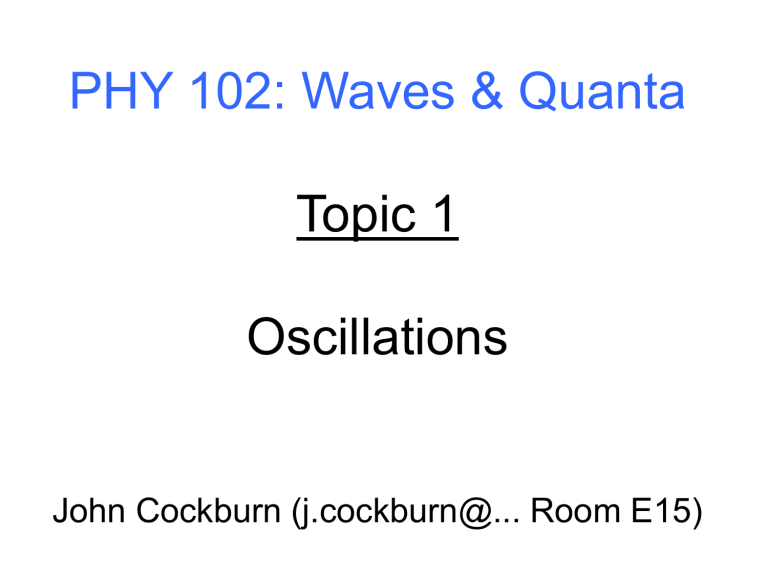
PHY 102: Waves & Quanta Topic 1 Oscillations John Cockburn (j.cockburn@... Room E15) •Simple Harmonic Motion revision •Displacement, velocity and acceleration in SHM •Energy in SHM •Damped harmonic motion •Forced Oscillations •Resonance Simple Harmonic Motion Object (eg mass on a spring, pendulum bob) experiences restoring force F, directed towards the equilibrium position, proportional in magnitude to the displacement from equilibrium: F kx Solution: d 2x m 2 kx dt 2 d x 2 x 2 dt k m x(t) = Example: Simple Pendulum (small amplitude) (NOT SHM for large amplitude) SHM and Circular motion Light Displacement of oscillating object = projection on x-axis of object undergoing circular motion y(t) = Acos For rotational motion with angular frequency , displacement at time t: y(t) = Acos (t + ) = angular displacement at t=0 (phase constant) A = amplitude of oscillation (= radius of circle) Velocity and acceleration in SHM Displaceme nt : x(t ) A cos(t ) dx Velocity : v(t ) dt d 2x Accelerati on : a (t ) 2 dt Velocity and acceleration in SHM Displaceme nt : x(t ) A cos(t ) dx A sin( t ) dt d 2x Accelerati on : a (t ) 2 2 A cos(t ) dt Velocity : v(t ) Energy in Simple Harmonic Motion Potential energy: Work done to stretch spring by an amount dx = Fdx = -kxdx Total work done to stretch spring to displacement x: W stored potential energy So, at any time t, the potential energy of the oscillator is given by: PE Energy in Simple Harmonic Motion Kinetic Energy: At any time t, kinetic energy given by: 2 1 2 1 dx KE mv m 2 2 dt Total Energy at time t = KE + PE: E Energy in Simple Harmonic Motion Conclusions Total energy in SHM is constant 1 1 2 2 2 E m A kA 2 2 Throughout oscillation, KE continually being transformed into PE and vice versa, but TOTAL ENERGY remains constant Energy in Simple Harmonic Motion Damped Oscillations In most “real life” situations, oscillations are always damped (air, fluid resistance etc) In this case, amplitude of oscillation is not constant, but decays with time..(www.scar.utoronto.ca/~pat/fun/JAVA/dho/dho.html) Damped Oscillations For damped oscillations, simplest case is when the damping force is proportional to the velocity of the oscillating object In this case, amplitude decays exponentially: x(t ) Ae(b 2 m)t cos( ' t ) Equation of motion: d 2x dx m 2 kx b dt dt Damped Oscillations NB: in addition to time dependent amplitude, the damped oscillator also has modified frequency: k b2 ' 2 m 4m Light Damping (small b/m) 2 b2 0 2 4m Heavy Damping (large b/m) Critical Damping k b2 m 4m 2 Forced Oscillations & Resonance If we apply a periodically varying driving force to an oscillator (rather than just leaving it to vibrate on its own) we have a FORCED OSCILLATION Free Oscillation with damping: d 2x dx m 2 b kx 0 dt dt Amplitude A0 e (b 2 m )t k b2 Frequency ' 2 m 4m 2 b2 0 2 4m Forced Oscillation with damping: d 2x dx m 2 b kx F0 cos Dt dt dt Amplitude k - m F0 b 2 2 D 2 2 D MAXIMUM AMPLITUDE WHEN DENOMINATOR MINIMISED: k = mD2 ie when driving frequency = natural frequency of the UNDAMPED oscillator k D 0 m Forced Oscillations & Resonance When driving frequency = natural frequency of oscillator, amplitude is maximum. We say the system is in RESONANCE “Sharpness” of resonance peak described by quality factor (Q) High Q = sharp resonance Damping reduces Q The Millennium Bridge



